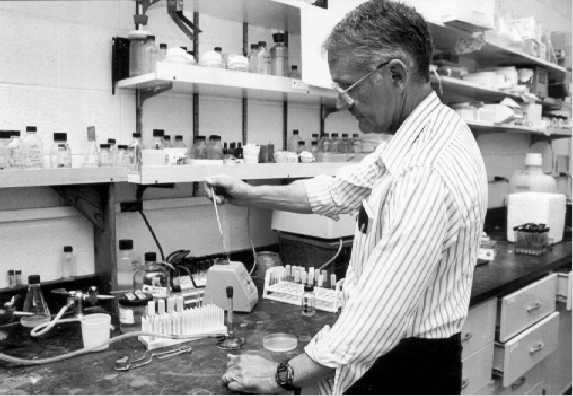by Jess Williams, NMSU University Communications
When Skip Botsford sings “Am I Blue?” it’s a happy song.

Botsford, a biology professor at New Mexico State University, recently patented a chemical toxicity test that he, with the help of an army of undergraduate students, developed and perfected over the last two and a half years.
Using bacteria that grow naturally on alfalfa, Botsford created a simple, cheap and quick test that shows whether different chemical compounds are toxic. The bacteria are suspended in a solution with a special dye and the chemical compounds are added. If the solution turns blue, there is no toxicity. If it turns yellow, watch out.
His system, Botsford claims, has the potential to save millions of laboratory rats and mice that traditionally have been used in toxicity testing, often with results that did not translate well to human exposure. And the process is so simple, he said, that undergraduate college students can be employed to conduct the testing.
It is, Botsford said, “by far, the cheapest, fastest and simplest” toxicity test of its kind, and the results are useful to companies introducing new products, municipalities dealing with unidentified spills, and consumers who want to know what they’re using in their homes and gardens. He said he hopes the patent can be sold to a corporation that will market it heavily to Third World countries, where industrial pollution can be curbed using the data. Botsford said any proceeds from the sale of the patent would be split between him and NMSU.
Other benefactors of the process, Botsford said, are his students, who have accumulated real-time lab work on the development of the process. Botsford said that when he was in college in the 1960s, most science laboratories were the exclusive and mysterious domain of professors and selected graduate students. Undergraduates need not apply. At most universities in the nation, he said, not much has changed in the intervening 30 years. But at NMSU, the labs are open to enterprising undergraduates who are willing to enhance their academic studies with hands-on scientific pursuits.
Botsford said he uses up to a dozen students each semester in his lab work. The students in the labs, he said, can test any one of the approximately 100,000 different chemicals that are put on the market each year. Each test takes less than an hour and costs about 47 cents. Traditional animal testing, he said, can take months and involve costs in the thousands of dollars for just one compound.
Advising between 140-190 undergraduates at NMSU each semester, Botsford encourages each of them to find a professor who will assign credit hours for lab work so that the students can be in on such ground-breaking innovations. Whether the nature of the work is new-fangled computer modeling or old-fashioned observation is not the issue, Botsford said.
What’s important is to use university resources as early and as often as possible. From biology labs to chemistry labs, physics labs, genetics labs, engineering labs, astronomy labs, agricultural labs and entomology labs, Botsford said there is work to be done and, in most cases, opportunities for undergraduates to be involved.
Note: The WRRI provided Botsford with funding for his research project, An Assay for Toxic Chemicals Using Microorganisms, and he will speak at this year’s annual water conference on the results of the project.
